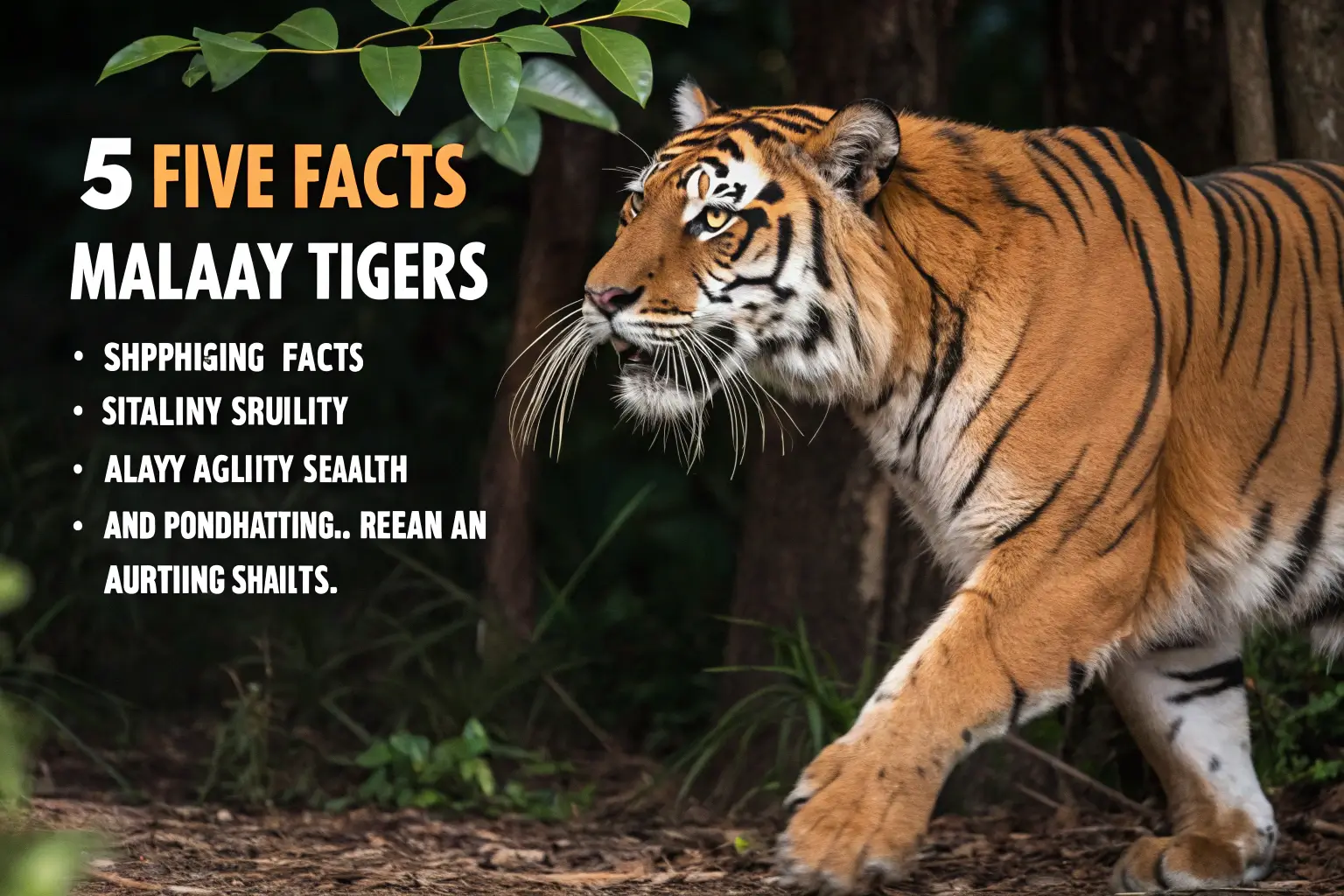Tiger Malay Traits: 5 Surprising Facts You’ll Love to Know
Introduction
The tiger Malay, often shrouded in mystery and magnificence, represents one of nature’s most breathtaking predators. With its distinctive orange coat slashed with dramatic black stripes, this majestic big cat has captured human imagination for centuries. Native to the lush rainforests of Southeast Asia, the tiger Malay combines raw power with surprising stealth, making it both feared and revered throughout its natural range.
Understanding the tiger Malay isn’t just about appreciating a beautiful animal—it’s about connecting with our planet’s vanishing wilderness. As apex predators, these tigers maintain ecological balance in their habitats, controlling prey populations and indirectly shaping forest structures. Their declining numbers tell a critical story about habitat loss and human encroachment that affects countless other species.
Did you know that a tiger Malay can identify individual humans by their scent alone? This extraordinary sensory ability—about 25 times more powerful than human olfaction—enables these predators to track prey through dense jungle undergrowth even days after the animal has passed. It’s just one example of the remarkable adaptations we’ll explore in this fascinating journey into the world of the tiger Malay.
Species Overview
Scientific Name and Classification
The tiger Malay, scientifically known as Panthera tigris jacksoni (sometimes classified as Panthera tigris malayensis), belongs to the Felidae family. Named after the conservationist Peter Jackson, this subspecies was only recognized as distinct from other tiger populations in 2004 after genetic studies revealed its unique characteristics. The tiger Malay represents one of the smallest living tiger subspecies, though it remains a formidable predator in its ecosystem.
Physical Characteristics
A mature tiger Malay typically weighs between 220-300 pounds (100-140 kg), with males significantly larger than females. Standing approximately 2-2.5 feet (60-75 cm) at the shoulder and measuring 7-8 feet (2.1-2.4 meters) in length, these tigers are compact yet powerful. Their coat features a vibrant orange base with narrower black stripes compared to other tiger subspecies, an adaptation that provides optimal camouflage in the dappled light of dense rainforests.
The tiger Malay’s head displays a distinctive rounded shape, with small ears marked by prominent white spots on the back—believed to help cubs follow their mother through thick vegetation. Their eyes, typically amber or golden, possess excellent night vision, with retinas containing six times more rod cells than human eyes, enabling these nocturnal hunters to see effectively in near-darkness.
Subspecies and Regional Variations
While not divided into further subspecies, tiger Malay populations show slight variations depending on their specific habitat. Those living in higher elevations tend to have slightly thicker fur, while tigers from southern regions often display more pronounced striping patterns. These subtle differences represent evolutionary responses to local environmental conditions rather than true subspecies differentiation.
Conservation geneticists continue studying these variations to understand how isolated populations adapt to their specific environmental niches, information crucial for preservation efforts as habitat fragmentation increases.
Habitat and Distribution
Natural Habitat
The tiger Malay thrives in tropical and subtropical moist broadleaf forests, preferring lowland areas with dense vegetation and access to water sources. These tigers require large territories with sufficient prey, adequate cover for stalking, and secluded denning sites for raising cubs. Primary and secondary rainforests provide ideal habitat, though some populations have adapted to live in peat swamp forests and hilly terrain up to 3,000 feet (900 meters) elevation.
Each tiger maintains a territory marking its boundaries through scent marking, scratch marks on trees, and occasional vocalizations. Male territories typically encompass 40-80 square miles (100-200 square kilometers), often overlapping with several female territories of approximately 7-20 square miles (18-50 square kilometers).
Geographic Range
Historically, the tiger Malay roamed throughout the Malay Peninsula, including parts of Thailand, Malaysia, and possibly southern Myanmar. Today, their range has contracted dramatically, with remaining populations primarily confined to protected areas in central and southern Malaysia. Small, isolated groups may persist in Thailand’s southernmost regions, though recent confirmed sightings remain scarce.
The Taman Negara National Park in Malaysia represents one of their last strongholds, along with the Endau-Rompin National Park and selected forest reserves in Perak and Kelantan states. Recent camera-trap studies suggest fewer than 200 individuals may remain in the wild, making this one of the most critically endangered tiger subspecies.
Adaptations to Environment
The tiger Malay has evolved remarkable adaptations for rainforest living. Their relatively smaller size allows greater maneuverability through dense vegetation, while their narrower striping pattern provides superior camouflage in filtered forest light. Oversized paws distribute weight effectively on soft forest floors and swampy terrain, and their powerful swimming abilities help them navigate the numerous waterways throughout their range.
Perhaps most impressive are their sensory adaptations—whiskers that detect minute air movements when stalking in darkness, sensitive hearing that can detect prey movement from hundreds of yards away, and scent receptors capable of determining not just what passed by but how recently. These adaptations make the tiger Malay perfectly suited to its rainforest home, where visibility rarely exceeds a few dozen yards.
Diet and Feeding Habits

What It Eats
The tiger Malay exemplifies obligate carnivory, requiring meat-based nutrition for survival. Their primary prey consists of wild pigs, various deer species (particularly sambar and barking deer), bearded pigs, and occasionally smaller mammals like pangolins and porcupines. When larger prey becomes scarce, they’ll hunt monkeys, pheasants, fish, and even young elephants or rhinos when opportunity presents.
A typical adult requires approximately 10-15 pounds (4.5-7 kg) of meat daily, though they often go several days between successful hunts. When making a large kill, a tiger Malay can consume up to 88 pounds (40 kg) in one feeding session, after which it may fast for days while digesting.
Hunting or Foraging Behavior
As ambush predators, the tiger Malay relies on stealth rather than speed for hunting success. They’ll stalk prey using all available cover, sometimes following potential targets for hours while remaining undetected. Their striped camouflage breaks up their outline in dappled forest light, making them nearly invisible to prey until the final moment.
The actual attack happens with explosive speed—covering 20-30 feet in a single bound—typically targeting the prey’s neck or throat. Their powerful jaws, with canine teeth reaching 3 inches (7.6 cm) in length, deliver a killing bite that severs the spinal cord or suffocates larger prey. Success rates vary dramatically depending on prey species and habitat conditions, ranging from 10% for larger prey to over 50% for smaller mammals.
Dietary Needs
The tiger Malay’s diet provides specialized nutrition essential for their survival. Their exclusively meat-based diet supplies concentrated protein for muscle maintenance, alongside fat-soluble vitamins crucial for reproduction and vision. They instinctively consume organ meats first after a kill, targeting nutrient-rich tissues like liver and kidneys that contain essential micronutrients.
Unlike herbivores, these tigers have a relatively short digestive tract optimized for protein processing rather than plant fiber. This carnivore-specific digestive system extracts maximum nutrition from meat but requires the tiger to supplement with specific behaviors like fur and bone consumption, which provide necessary roughage and calcium.
Behavior and Social Structure
Social Behavior
Despite popular misconceptions about big cats, the tiger Malay maintains a primarily solitary lifestyle. Adults typically interact only for breeding purposes, with males and females maintaining separate territories that may partially overlap. This solitary nature reflects an evolutionary adaptation to hunting large prey in dense forest environments, where group hunting offers fewer advantages than in open terrain.
Exceptions to this solitary pattern occur primarily with mothers and cubs, who remain together for approximately two years while the young learn essential hunting and survival skills. During this period, the family group develops complex social bonds, with sophisticated play behaviors that develop crucial predatory skills in a safe learning environment.
Communication
The tiger Malay employs a sophisticated communication system combining vocalizations, body language, and scent marking. Their iconic roar—audible up to three miles away—serves primarily as a territorial announcement and mate attraction signal. More common are chuffs, prusten (a reassuring sound made especially toward cubs), and various growls that convey specific emotional states.
Scent communication plays an equally important role, with specialized glands producing unique chemical signatures that mark territory boundaries and signal reproductive readiness. Tigers regularly spray urine, deposit feces in prominent locations, and rub glandular secretions on trees to create a complex olfactory landscape intelligible to other tigers but invisible to humans.
Mating and Reproduction
Breeding occurs year-round in the tiger Malay population, though slight increases in mating activity correlate with prey abundance. Females become receptive for 3-7 days every 3-9 weeks, signaling readiness through increased vocalizations and scent marking. During courtship, the normally solitary male and female may remain together for 2-5 days, mating multiple times before separating.
After a gestation period of approximately 103 days, females give birth to 2-4 cubs in secluded dens—often located in caves, hollow trees, or dense vegetation. The cubs, born blind and weighing only 2-3 pounds (0.9-1.4 kg), depend entirely on their mother for the first few months. Reaching independence at 18-24 months, young tigers must eventually establish their own territories, often facing dangerous confrontations with established adults during this vulnerable period.
Conservation Status
Endangerment Level
The tiger Malay faces a precarious future, classified as Critically Endangered by the International Union for Conservation of Nature (IUCN). Current estimates suggest fewer than 200 individuals remain in the wild—possibly as few as 150—representing a catastrophic 93% population decline since the early 20th century. This dramatic reduction places the subspecies at extreme risk of extinction within the next two decades without significant intervention.
Population viability analyses indicate the minimum sustainable population for long-term genetic health should exceed 250 breeding adults—a threshold the wild population falls well below. This genetic bottleneck raises serious concerns about inbreeding depression, reduced disease resistance, and diminished adaptive capacity in the face of environmental changes.
Threats
Habitat loss represents the most immediate threat to tiger Malay survival. Approximately 93% of their historical range has been converted to plantations (primarily palm oil and rubber), mining operations, and human settlements. The remaining forest exists primarily as isolated fragments, preventing normal territorial expansion and genetic exchange between populations.
Poaching constitutes the second major threat, driven by the lucrative black market for tiger parts in traditional Asian medicine and luxury items. A single tiger can bring poachers upwards of $50,000, creating powerful economic incentives for illegal hunting. Additionally, human-tiger conflict increases as diminishing natural prey forces tigers to target livestock, often resulting in retaliatory killings.
Conservation Efforts
Multiple conservation initiatives now focus on saving the tiger Malay from extinction. The Malaysian Conservation Alliance for Tigers (MYCAT) coordinates protection efforts across governmental and non-governmental organizations, implementing anti-poaching patrols, habitat restoration, and community education programs. Wildlife corridors connecting isolated forest fragments have been established in several regions, allowing tigers safe passage between protected areas.
Advanced monitoring technologies, including camera trap networks and satellite tracking of collared individuals, provide crucial data for conservation planning. Captive breeding programs maintain genetic reservoirs that may eventually support reintroduction efforts, though conservationists emphasize that habitat preservation remains the highest priority for meaningful recovery.
Interesting Facts
Master Mimics: The tiger Malay possesses an unusual ability to imitate the calls of some prey species, particularly muntjac deer and sambar. This vocal mimicry occasionally lures curious prey into ambush range—a behavior rarely documented in other big cats.
Memory Masters: Studies of captive tigers reveal extraordinary spatial memory, with individuals remembering specific locations and events for years. Wild tiger Malays likely use this cognitive advantage to navigate their extensive territories and recall successful hunting locations across seasons.
Swimming Enthusiasts: Unlike many feline species, the tiger Malay actively enjoys water and excels at swimming. They can cross rivers up to 5 miles (8 kilometers) wide and have been documented swimming between small islands in search of prey or new territory.
Temperature-Dependent Sex Determination: Research suggests environmental temperature during specific gestational periods may influence cub sex ratios, with higher temperatures potentially producing more males—a phenomenon that could further complicate conservation under climate change scenarios.
Unique Stripe Patterns: Each tiger Malay possesses a stripe pattern as distinctive as human fingerprints, allowing researchers to identify individuals from photographs. Specialized software now catalogs these patterns, enabling population monitoring without invasive tagging procedures.
Tips for Caring for the Animal
While tiger Malay specimens never serve as appropriate pets under any circumstances, various conservation centers and accredited zoos maintain captive populations for research, education, and potential reintroduction programs. These facilities implement specialized care protocols addressing the species’ unique requirements.
Proper enclosure design represents the most critical aspect of captive care, with minimal space requirements of 1,000+ square feet (93+ square meters) per individual, incorporating natural vegetation, water features, elevated resting platforms, and private denning areas. Environmental enrichment programs prevent psychological stress, utilizing scent trails, novel objects, and puzzle feeders that stimulate natural hunting behaviors.
Nutrition follows carefully calculated protocols, typically providing 10-15 pounds (4.5-7 kg) of meat daily, primarily horse, beef, or specialized commercial feline diets supplemented with vitamins and minerals. Whole-carcass feeding occasionally occurs to simulate natural consumption patterns, providing necessary roughage and dental benefits.
Role in the Ecosystem
Ecological Importance
The tiger Malay fulfills the critical ecological role of apex predator within its rainforest habitat. By controlling herbivore populations—particularly deer and wild pigs—tigers prevent overgrazing that would otherwise damage forest structure and composition. Research in similar ecosystems demonstrates that removing apex predators triggers trophic cascades affecting everything from vegetation patterns to soil composition.
Their predatory activities create a “landscape of fear” that alters prey behavior and movement patterns, indirectly determining which plant species receive heavy browsing pressure. This regulatory function maintains biodiversity by preventing any single herbivore species from dominating the ecosystem.
Impact of Decline
The continuing decline of tiger Malay populations has triggered measurable ecological changes throughout their range. Areas experiencing tiger extirpation show dramatic increases in wild pig and deer populations, leading to overgrazing of preferred plant species and reduced forest regeneration. This vegetation shift affects countless other species, from insects to primates that depend on specific forest structures.
The tiger’s disappearance also impacts scavenger communities that historically relied on tiger kills for supplementary nutrition. Various endangered vulture species, dholes (Asian wild dogs), and smaller carnivores benefit from tiger-killed carcasses, gaining critical food resources without expending hunting energy. Without these shared resources, competition intensifies among remaining predators, potentially triggering secondary extinction events.
Conclusion
The tiger Malay embodies both the splendor of nature’s evolutionary achievements and the profound consequences of human activity on our planet’s biodiversity. From its extraordinary sensory capabilities to its crucial ecological role, this magnificent predator represents far more than simply another endangered species—it serves as a living barometer for the health of entire rainforest ecosystems.
The knowledge we’ve explored—from the tiger’s unique physical traits to its complex social behaviors—offers more than fascination; it provides essential context for meaningful conservation. Understanding what makes the tiger Malay special creates powerful motivation for protecting both the species and its vanishing habitat.
Each of us can contribute to tiger conservation through mindful consumer choices—particularly avoiding products containing palm oil from unverified sources—supporting reputable conservation organizations, and raising awareness about the critical situation facing these magnificent animals. By taking action today, we help ensure future generations will know the tiger Malay not just from photographs and stories, but as a living, breathing testament to nature’s enduring resilience.
Frequently Asked Questions
Are tiger Malays different from other tiger subspecies?
Yes, the tiger Malay (Panthera tigris jacksoni) represents a genetically distinct subspecies recognized in 2004. They’re typically smaller than other tiger subspecies, with narrower black stripes adapted for better camouflage in dense rainforests. Their physical adaptations specifically suit Southeast Asian jungle environments, including slightly smaller size for better maneuverability in thick vegetation.
How many tiger Malays remain in the wild?
Current estimates place the wild tiger Malay population at fewer than 200 individuals—possibly as low as 150—primarily in protected areas of Malaysia. This represents a catastrophic decline of approximately 93% from their historical population. Without significant conservation intervention, experts fear this subspecies could become extinct in the wild within 20 years.
Can tiger Malays be kept as pets?
Absolutely not. Tiger Malays are wild animals with specific needs that cannot be met in domestic settings. Keeping them as pets is illegal in most countries, dangerous to humans, and detrimental to the animals’ welfare. Any facility claiming to offer “pet” tigers operates outside ethical wildlife management practices and likely contributes to wildlife trafficking.
What’s the difference between a tiger Malay and a Malayan tiger?
There is no difference—”tiger Malay” and “Malayan tiger” refer to the same subspecies (Panthera tigris jacksoni). “Malayan tiger” represents the more commonly used scientific terminology, while “tiger Malay” appears in some regional contexts and popular literature. Both terms identify the critically endangered tiger population native to the Malay Peninsula.
How can I help protect tiger Malays?
You can support tiger Malay conservation by donating to reputable organizations like the World Wildlife Fund or Malaysian Conservation Alliance for Tigers, avoiding products containing unsustainable palm oil (a major driver of habitat destruction), spreading awareness about their endangered status, and supporting ecotourism initiatives that provide economic alternatives to poaching and deforestation in their habitat areas.







